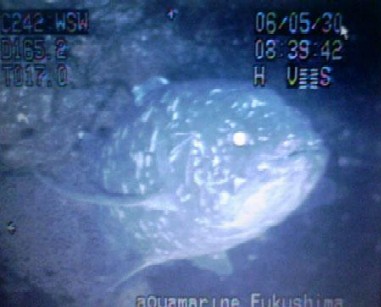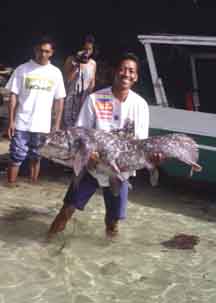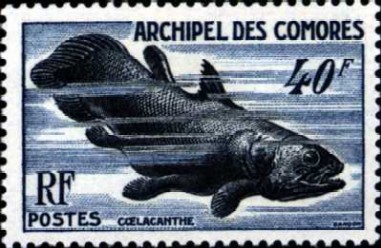Indonesian Coelacanth Filmed
Posted by: Loren Coleman on May 31st, 2006
Updated at 11:15 PM, May 31, 2006, plus image.

A capture of an image from the Japanese research team videotape of a one-meter long coelacanth taken off Indonesia on May 30, 2006. No date for the release of the video has been given.
Robin Stobbs, a coelacanth researcher in South Africa, has informed me that an individual of the Indonesian coelacanth was filmed at the depth of 170 m, 17, at 8:30 am on May 30, 2006, off shore Buol, about 350 km west from Manado, Sulawesi Island, with a ROV operated by the Aquamarine Fukushima Survey team. This town is only a few miles (east) from where the Jago team saw two coelacanths in a cave near ToliToli. Word now comes that two other coelacanths were seen on May 31, 2006, at Buol.
The African species (the beautiful blue ones) was re-discovered in 1938, and for decades people thought that’s all there was. In the 1990s, they were finally filmed live.
But then in 1998, to the surprise of zoologists and ichthyologists worldwide, 6000 miles away, a whole new and different species (they are the beautiful brownish variety) of coelacanth were discovered off Indonesia. This videotaping of this fish is news because it is the "first video of a coelacanth in its Indonesian habitat since a German team videotaped one in 1999," according to Jiji, Chunichi Shimbun. From the one image seen (above), it does appear to be remarkable footage.

Above photograph: The first Indonesian coelacanth captured by locals, on behalf of scientists Mark and Arnaz Mehta Erdmann, who described the discovery in the September 24, 1998 issue of Nature. Photo courtesy of the Erdmanns.
This new filming may vindicate Indonesian coelacanth discoverer Mark Erdmann’s thoughts on the species.
The African coelacanth has the species name Latimeria chalunnae. The Indonesian species, which besides allegedly being brown has gold flecks on its sides, is offically named Latimeria menadoensis. Several pages in Cryptozoology A to Z discuss the differences and significance between the two stories of these darlings of cryptozoology, but also note that Mark Erdmann has his doubts about the two different species. Now this new video may prove he is correct.
The color of the newly filmed coelacanth appears to not be brown: "The camera light caused the fish’s eyes to glow green. It was there. Its body was dark blue," the research team reported to museum director Yoshitaka Abe to the Japanese media. That’s "dark blue" or “blue-black” (ao-guroi in Japanese), and I thank Edo for the translation. This finding, that there is one species worldwide with different colorations, as opposed to a different brown species in Indonesian waters, would be intriguing news, if verified further.
Haven’t the disputed French DNA analyses been retested yet?
Below, the African variety of Latimeria.

About Loren Coleman
Loren Coleman is one of the world’s leading cryptozoologists, some say “the” leading living cryptozoologist. Certainly, he is acknowledged as the current living American researcher and writer who has most popularized cryptozoology in the late 20th and early 21st centuries.
Starting his fieldwork and investigations in 1960, after traveling and trekking extensively in pursuit of cryptozoological mysteries, Coleman began writing to share his experiences in 1969. An honorary member of Ivan T. Sanderson’s Society for the Investigation of the Unexplained in the 1970s, Coleman has been bestowed with similar honorary memberships of the North Idaho College Cryptozoology Club in 1983, and in subsequent years, that of the British Columbia Scientific Cryptozoology Club, CryptoSafari International, and other international organizations. He was also a Life Member and Benefactor of the International Society of Cryptozoology (now-defunct).
Loren Coleman’s daily blog, as a member of the Cryptomundo Team, served as an ongoing avenue of communication for the ever-growing body of cryptozoo news from 2005 through 2013. He returned as an infrequent contributor beginning Halloween week of 2015.
Coleman is the founder in 2003, and current director of the International Cryptozoology Museum in Portland, Maine.










Im not sure whats this is. A fish that went extinct? I dont know, can someone fill me in. Bye the way a little while ago there was a post about where everyone is from, I am a Mainer just like Loren and live not to far from Portland.
Mauka –
Yes, the coelacanth is a prehistoric fish that was supposedly extinct, but was recently rediscovered. They are still very rare, however.
This is exciting news. I hope the video will be released to the public soon!
i saw a documentary on discovery or national geographic once. it was about coelacanths, and they were filmed quite deep down in a cave.i think that was off the coast of africa though.still,it was fascinating!
Maybe some day some of our favorite cryptids will be referred to as “recently discovered…” wouldn’t it be great?
Fantastic…I cannot wait to see the footage.
Toirtis I agree the footage will be a nice sight to see.
Fascinating. I agree with Toirtis. More and more discoveries are now being backed up with great proof. Not that there wasn’t enough in the first place.
I want to draw a picture of that creature.
Thunderstorm is about to hit. Will watch the film tomorrow.
Interesting, i always envisaged them as totally benthic, and “walking” on bottom substrate.
Color morphs aren’t exactly unknown in icthyology. And if as I’m reading it the color might indicate only one species, well my world’s not being shaken by that either. Many fish species are circumtropical, heck, circumglobal. Why not this one…?
DWA
“Why not this one…?”
Perhaps because it is presumed to be very very rare and previously thought to be extinct? Ok there are many fish with wide distribution, but distribution often goes hand in hand with knowledge about the species, i.e. common animals are well described! This is interesting because little is known about the species. Would you loose all interest in BF once it has been found and identified?
Rana: I think you’re missing my thrust here.
Now that we know the thing exists, something we’ve known since 1938, it shouldn’t be a shock either to find out that (a) the formerly-two-species are in fact one (happens all the time in biology; for example with birds it happens every year or two) or (b) that they’re two species.
The “earthshaking” stuff’s been done. (As it will have been once relict hominoids are confirmed.) After that it’s just sorting out data.
As exciting, of course, as that will be.
But surely this blog is simply interesting information that was not known. Ok It is well know that species classification is changing all the time with taxanomic inflation and all, but here were just given more insight into a little known and mysterious animal! Can we not just take it as that?
well ok it is! Interesting non the less!
“Perhaps because it is presumed to be very very rare and previously thought to be extinct?”
The key word there is “presumed”. We found the two known populations by accident, and there’s no way of knowing how many others there might be out there…
Exactly, an thats why its interesting! If something presumed extinct could infact be numerous then there is more hope that many other species may still be extanct or undiscovered as yet!
Whether they are two distinct species, or simply regional variations or “sub-species”, the coelacanth deserves study.
One thing I think we don’t talk about enough in cryptozoology is the possible development of brand new species or sub-species in isolated populations and what this could mean to the field.
Take, for example, the chimpanzee/bonobo/bili ape distinctions. While the bonobo now get seperate billing, most of the things I’ve read on the bili ape consider it a “sub-species” of the common chimpanzee.
But at what point does the isolation of a sub-species lead to the development of a new species? For instance there are 5 different varieties of wild turkey found in the U.S. (Eastern, Osceola, Merriam’s, Rio Grande and Gould’s) and they exhibit differences in size, coloration, and habits. However they are all considered the same species. Turkeys, of course, can fly very well, so natural barriers like the Mississippi River aren’t that big of an issue. But what if other barriers lead to isolation for a sub-species. How long before they could no longer produce viable offspring with others of their “specie” and are then considered a distinct species instead of a subspecies.
And, why are some genetically compatible species considered different species instead of sub-species. For instance wolves and domestic dogs (canis lupus and canis familiarus) were originally considered seperate, but now domestic dogs are considered a sub-specie of the wolf and have been reclassified as canis lupus familiarus. This makes sense, as dogs and wolves can, and according to the folks at swap meets often do, produce viable offspring.
However when you talk about coyote (canis latrans), things are different. Coyote and dogs can reproduce however, from my readings, these offspring are almost always the result of male dogs and female coyote and, while these offspring aren’t infertile like mules, it is difficult for them to reproduce. The reason for this (and the fact that the offspring are most often male dog/female coyote crosses) results from the unique nature of male coyote fertility. From my reading (and this is as a layperson, so biologists please feel free to correct me here) like females, male coyotes are fertile in “cycles” that correspond to female estrus, whereas male dogs are always fertile. This makes it easier then for a male dog to impregnate a female coyote than vice versa. When the offspring are born, however, the fertility cycle in the males are “out of synch” making it difficult for them to then reproduce. As a result the animals are practically, if not actually, fertile.
So what we see here is a genetic “dead end” in the interbreeding of closely related species.
While I know I’ve now gone way away from the original coelacanth post, the bigger, generic question that was raised remains. At what point are two related species “different species” and not “sub-species” or regional variants?
I mean, back to dogs, archaelogists a million years from now could be forgiven for assuming that a chihuahua and a great dane were two seperate species of canid, based simply on the morphological difference, even though genetics tell us they are both just really in-bred wolves.
And back to our favorite cryptids, the hairy hominids, what about the tales of drunken villagers impregnating adopted almases, or of BF kidnapping humans? Would the offspring be like the coydog? Like a mule? Or like a perfectly fertile collie/beagle mix?
Just some food for thought.
Interesting questions Mr Wells and they are issues I have tried to bring up many times here before. The definition of what constitutes a species depends in most instances on what question your trying to answer. The Most commonly adopted Biological Species Concept (Mayer) defines species as groups of interbreeding natural populations that are reproductively isolated from other such group. As you point out isolation takes many forms including physical barriers, temporal asynchrony as well as biological pre and post zygotic factors. Many problems arise with this theory however i.e. hybrids with increased fitness, and populations in allopatry (isolated), such as the European red dear and the north American elk, both species (Cervus elaphus) are they separate species though because naturally they will never meet and exchange genes.
Species definition and validity is a hot topic in ecology, if you’re interested there are lots of good papers try searching for Species concepts or Taxonomic inflation or NJ Isaac, J Mallet, GM Mace on Google scholar should give you a good start!
Lots of interesting facts figures and stats to be found in resent papers that I would have thought would act as useful tools in a cryptozoologists armoury in the fight against scepticism. However there seems to be a lack of enthusiasm by many when it comes to “mainstream science”. What is classed as “regular” or mainstream ecology and biology can be as mysterious as cryptozoology, I just wish they would move closer together as opposed to drifting apart.
Well, you mentioned the possibility of the Coelacanth as being circumtropical…there have been several reports suggesting A population somewhere in the Caribbean. Perhaps more effort should be done to uncover the truth of the matter?
a japanese group headed by Dr. Jun Inouye has recently sequenced the entire mitochondrial genome of both the Indonesian and the African coelacanth. The data show extensive diferences in the DNA sequences. The differences are comparable to the genetic differences between humans and new world monkeys (spider monkeys etc.). This suggests that the physical similarities in the two forms are a reflection of highly constrained evolutionary divergence. They are unlikely to be the same species by almost any of the rigorous criteria used to assess species disctinctness. Its quite remarkable to see such conservation in morphology with such differences in the DNA sequences.